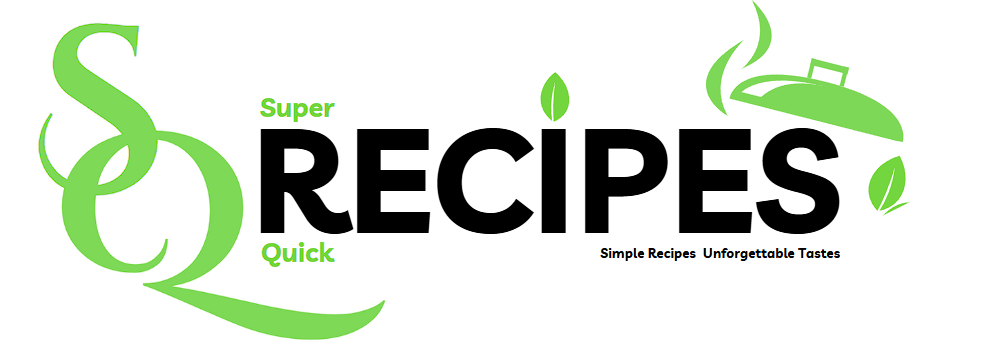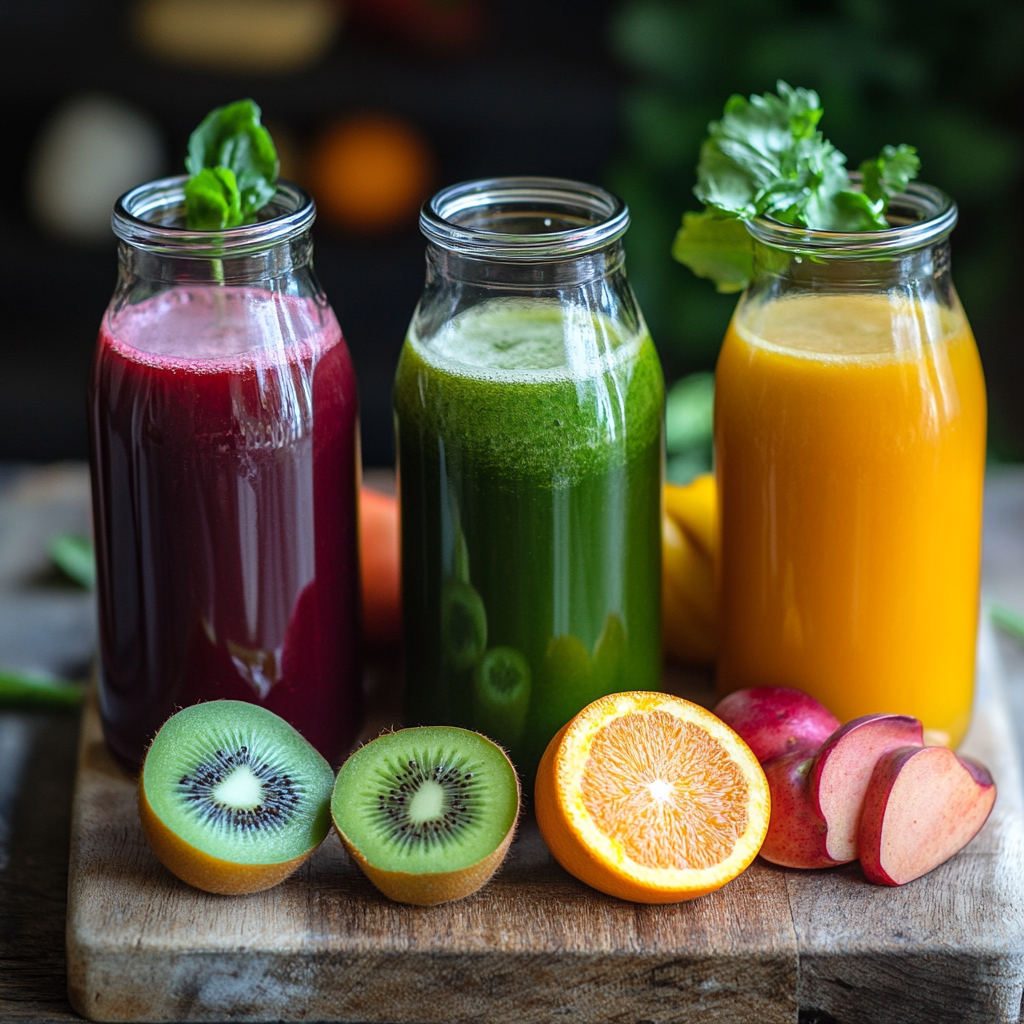Overview of the 3-Day Juice Cleanse Recipes Plan
This 3-day juice 3-Day Juice Cleanse Recipes are designed to help detoxify your body, boost energy, and improve digestion. Each day consists of three main juices—morning, midday, and evening—crafted with specific ingredients to support different functions in the body.
Daily Juice Schedule:
- Morning Juice – Designed to wake up your system and kickstart digestion.
- Midday Juice – Provides hydration and essential nutrients for sustained energy.
- Evening Juice – Helps with detoxification and liver support before bedtime.
Each recipe is made using fresh, organic ingredients and should be consumed immediately after juicing for maximum nutrient retention.
Day 1: Detox & Hydration Juices
The first day focuses on hydration and flushing out toxins while preparing your digestive system for cleansing.
Morning Juice: Green Detox Elixir
This juice is rich in chlorophyll, antioxidants, and digestive enzymes, helping to cleanse the liver and boost energy.
Ingredients:
- 1 cup kale
- 1 cucumber
- 1 green apple
- ½ lemon, peeled
- 1-inch piece ginger
- ½ cup water (optional, for dilution)
Instructions:
- Wash all ingredients thoroughly.
- Run them through a juicer.
- Stir and drink immediately.
Midday Juice: Citrus Cleanser
Packed with vitamin C and anti-inflammatory compounds, this juice supports immune function and digestion.
Ingredients:
- 2 oranges, peeled
- 2 carrots
- 1-inch piece turmeric
- ½ cup pineapple chunks
Instructions:
- Juice all ingredients together.
- Stir and enjoy fresh.
Evening Juice: Beetroot Liver Cleanse
Beets are known for their liver-detoxifying properties, while lemon and ginger aid digestion.
Ingredients:
- 1 medium beet
- 1 apple
- ½ lemon, peeled
- 1-inch piece ginger
Instructions:
- Juice all ingredients together.
- Drink immediately.
Day 2: Energy & Immunity Boosting Juices
The second day focuses on increasing energy and strengthening the immune system with nutrient-dense ingredients.
Morning Juice: Sunrise Glow
This juice is packed with beta-carotene, vitamin C, and anti-inflammatory properties.
Ingredients:
- 3 carrots
- 1 orange, peeled
- 1-inch piece ginger
- ½ teaspoon turmeric powder or fresh turmeric
Instructions:
- Juice all ingredients together.
- Serve immediately.
Midday Juice: Green Goddess
This juice provides a refreshing energy boost with greens and hydrating ingredients.
Ingredients:
- 1 cup spinach
- 1 green apple
- ½ cucumber
- ½ lemon, peeled
- 1 celery stalk
Instructions:
- Juice all ingredients together.
- Stir well and drink immediately.
Evening Juice: Berry Antioxidant Booster
A delicious, antioxidant-rich juice to fight oxidative stress and aid muscle recovery.
Ingredients:
- ½ cup blueberries
- ½ cup raspberries
- ½ cup pomegranate seeds
- 1 tablespoon chia seeds (optional, soaked in water for 10 minutes before juicing)
Instructions:
- Blend all ingredients together (berries may not juice well).
- Serve immediately.
Day 3: Rejuvenation & Gut Health Juices
The final day focuses on gut health, digestion, and overall rejuvenation.
Morning Juice: Aloe Vera Digestive Soother
Aloe vera is known for soothing the digestive tract and reducing bloating.
Ingredients:
- ½ cup aloe vera gel (fresh or store-bought, no additives)
- 1 cup pineapple chunks
- 1 cup coconut water
- 5-6 fresh mint leaves
Instructions:
- Blend all ingredients together until smooth.
- Serve immediately
Midday Juice: Tropical Anti-Inflammatory Blend
The 3-Day Juice Cleanse Recipes contains powerful anti-inflammatory compounds from turmeric and ginger.
Ingredients:
- 1 mango, peeled and chopped
- 1-inch piece turmeric
- 1-inch piece ginger
- ½ lime, peeled
Instructions:
- Juice all ingredients together.
- Stir and enjoy.
Evening Juice: Nut Milk Protein Recovery
A nutrient-rich, protein-packed juice to replenish energy after cleansing.
Ingredients:
- 1 cup almond milk (unsweetened, homemade or store-bought)
- 2 dates, pitted
- ½ teaspoon cinnamon
- ¼ teaspoon vanilla extract
Instructions:
- Blend all ingredients together until smooth.
- Drink as a soothing, nutritious final juice of the cleanse.
Post-Cleanse Guide & Additional Tips:
How to Transition Out of a Juice Cleanse
Completing a 3-day juice detox is an achievement, but what you eat afterward is just as important. Jumping straight into heavy or processed foods can lead to digestive discomfort, bloating, and sluggishness. The key is to gradually reintroduce whole foods to avoid shocking your system.
Best Practices for Post-Cleanse Transition
- Ease Back Into Solid Foods – Start with light, plant-based meals like steamed vegetables, soups, and salads.
- Include Healthy Fats – Add avocados, nuts, seeds, and olive oil for better nutrient absorption.
- Stay Hydrated – Continue drinking at least two liters of water daily.
- Avoid Processed Foods – Steer clear of sugar, caffeine, alcohol, and fried foods for at least three to five days.
- Listen to Your Body – Pay attention to how your digestion responds to new foods.

Common Mistakes to Avoid During a Juice Cleanse
Even with good intentions, many people make avoidable mistakes that reduce the effectiveness of the cleanse. Being aware of these can help maximize results.
1. Not Preparing Properly
Going straight from processed foods to a juice cleanse can cause headaches, bloating, and fatigue. Always transition into the cleanse with a plant-based diet for a few days.
2. Not Drinking Enough Water
Juices hydrate, but they do not replace plain water. Aim for two to three liters per day to help flush out toxins.
3. Drinking Store-Bought Juices
Many bottled juices contain preservatives, pasteurization, and added sugars, which can sabotage the cleanse. Always opt for freshly made, cold-pressed juices.
4. Overloading on Sugary Fruits
While fruit provides essential vitamins, an excess of fruit juice can lead to blood sugar spikes and crashes. Balance juices with low-sugar vegetables such as kale, celery, and cucumber.
5. Exercising Too Intensely
A juice cleanse provides fewer calories than a regular diet, making intense exercise risky. Stick to gentle movement like yoga, walking, and stretching.
6. Expecting Extreme Weight Loss
While juice cleanses can result in reduced bloating and some weight loss, most of it is water weight. Long-term weight management depends on your post-cleanse diet and lifestyle.
7. Not Transitioning Properly Post-Cleanse
Rushing back to heavy, greasy, or processed foods can cause digestive discomfort. Follow the post-cleanse guide for a smooth transition.
Hydration & Detox Tea Options
In addition to fresh juices, staying hydrated supports the detox process and prevents side effects like headaches and fatigue.
Best Hydrating Drinks During a Juice Cleanse
- Lemon Water – Supports digestion and alkalizes the body.
- Coconut Water – Provides natural electrolytes for hydration.
- Herbal Detox Teas – Aids in digestion, reduces bloating, and supports liver function.
Recommended Detox Teas
- Ginger and Turmeric Tea – Reduces inflammation and soothes digestion.
- Peppermint Tea – Helps with bloating and promotes gut health.
- Dandelion Tea – Supports liver detoxification.
- Green Tea – Rich in antioxidants and boosts metabolism.
Drinking two to three cups of herbal tea daily can enhance the detox effects of a juice cleanse.
Can You Exercise During a Juice Cleanse?
Exercise is beneficial, but high-intensity workouts may leave you feeling weak or fatigued due to the lower calorie intake. Light physical activity is recommended to support circulation and maintain mobility.
Best Workouts for a Juice Cleanse
- Gentle Yoga – Improves circulation and reduces stress.
- Walking – Low-impact movement to boost energy.
- Stretching – Relieves detox symptoms like headaches or muscle tightness.
Workouts to Avoid
- High-intensity cardio such as running or HIIT workouts
- Heavy weightlifting
- Extended endurance training
Since caloric intake is limited, focusing on low-impact movement helps support the cleanse without overexerting the body.
Frequently Asked Questions (FAQs) About Juice Cleanses
1. Will I feel hungry during a juice cleanse?
Mild hunger is normal, especially on the first day. Drinking enough juice and water can help curb cravings.
2. Can I drink coffee during a juice cleanse?
It is best to avoid coffee, as caffeine can dehydrate the body and interfere with detoxification. Herbal teas are a good alternative.
3. Can I add protein powder to my juices?
Juice cleanses typically do not include protein powders, but if needed, you can add plant-based protein such as hemp or pea protein.
4. What if I get a headache during the cleanse?
Headaches are common due to caffeine withdrawal or detox symptoms. Staying hydrated, drinking lemon water, and resting can help alleviate discomfort.
5. Can I drink nut milk during a juice cleanse?
Some cleanses include homemade almond or cashew milk in the evening for extra protein and satiety.
6. How much weight can I lose on a 3-Day Juice Cleanse Recipes ?
Weight loss varies from person to person, but most people experience a reduction of three to five pounds in water weight. Long-term weight loss depends on your post-cleanse diet and activity level.
7. Can I extend the cleanse beyond three days?
A three-day cleanse is generally safe, but extending beyond this should be done with supervision from a nutritionist.
8. What happens if I eat solid food during the cleanse?
If you accidentally eat solid food, simply continue the cleanse without restarting.
9. Can I make juices in advance?
Fresh juices should be consumed immediately for the best nutrient retention, but they can be stored in airtight glass jars for up to 24 hours if necessary.
10. Is a juice cleanse safe for everyone?
Juice cleanses are not recommended for pregnant women, individuals with diabetes, or those with underlying medical conditions without consulting a healthcare professional.

